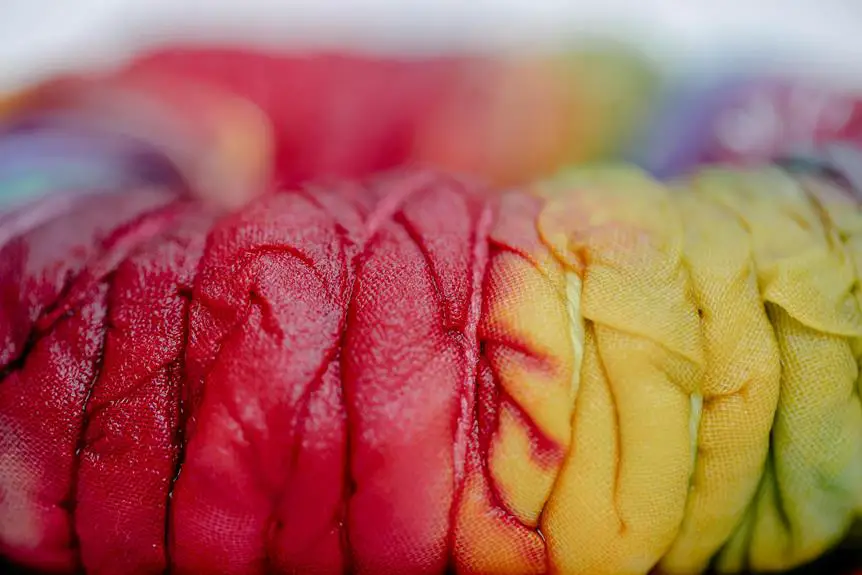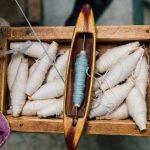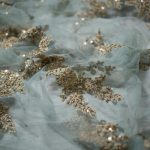You might be wondering about gossamer's potential when blended with other fibers. This lightweight material can enhance fabrics in surprising ways, but not all combinations yield the same results. Imagine the possibilities when gossamer meets luxurious silk or breathable cotton. Each blend carries its own set of benefits, yet also presents unique challenges. So, what happens when you explore those combinations further? The nuances of blending gossamer with other fibers could change how you think about fabric properties and applications in fashion.
Table of Contents
Understanding Gossamer Properties
Gossamer, known for its delicate and lightweight texture, offers unique properties that can enhance various fabric blends. When you handle gossamer, you'll notice its sheer quality, which makes it ideal for layering. This lightweight nature allows fabrics to breathe and drape beautifully without adding unnecessary bulk.
Another critical property of gossamer is its softness. You'll find that this fiber feels gentle against the skin, making it perfect for garments that require comfort, such as blouses and lingerie. Its fineness adds a luxurious touch, elevating the overall aesthetic of the fabric blend.
Additionally, gossamer's inherent strength shouldn't be overlooked. Though it appears delicate, it maintains durability, resisting wear and tear better than you might expect. This balance of fragility and toughness allows it to withstand everyday use while still providing that ethereal look.
Furthermore, gossamer can easily take on dye, opening up a range of vibrant colors. This versatility not only enhances visual appeal but also allows you to express creativity in your fabric combinations. By understanding these properties, you can make informed choices about blending gossamer with other fibers, achieving beautiful results.
Benefits of Blending Gossamer
Blending gossamer with other fibers brings you enhanced durability and strength, making your fabric more reliable.
You'll also notice improved moisture management, keeping you comfortable in various conditions.
These benefits can elevate your textile projects significantly.
Enhanced Durability and Strength
Combining gossamer with stronger fibers enhances durability, making fabrics more resistant to wear and tear. This blend not only improves the longevity of your garments but also provides you with the confidence to wear them in various situations.
When you choose such fabrics, you benefit from several key advantages:
- Increased Strength: The addition of robust fibers boosts overall fabric strength, helping prevent tears and frays.
- Improved Resistance: Blended fabrics resist stretching, deformation, and other common forms of damage better than pure gossamer options.
- Versatile Applications: Stronger composites can be used in a wider range of clothing, from everyday wear to specialized sports apparel, without compromising comfort.
Improved Moisture Management
Stronger fibers can effectively enhance moisture-wicking properties when integrated with gossamer, keeping you dry and comfortable throughout the day. When you combine gossamer with materials like polyester or nylon, you create a fabric that actively pulls moisture away from your skin. This means you won't feel weighed down or sticky during physical activities, making it an excellent choice for athletic wear.
The unique lightweight nature of gossamer ensures that even when blended with more moisture-absorbing fibers, the overall fabric remains breathable. This blend allows perspiration to evaporate more quickly, promoting a fresher feel and reducing the risk of chafing. You'll appreciate how these combinations maintain a comfortable temperature, making them ideal for warm climates or intense workouts.
Additionally, the improved moisture management can lead to enhanced performance, whether you're running, hiking, or simply going about your daily routine. You'll find that garments made from this blend aren't only functional but also stylish, allowing you to look good while staying dry.
Common Fibers to Blend With
When blending gossamer, you'll want to consider a few common fibers that can enhance its qualities.
Silk adds a luxurious touch, while cotton brings incredible softness to the mix.
Wool can also create intriguing textures and warmth, making it a great option to explore.
Silk and Gossamer Features
Blending silk with gossamer not only enhances the fabric's lightweight feel but also adds a luxurious sheen that's hard to resist.
This pairing creates a beautifully delicate material, perfect for garments that require both elegance and comfort.
When you work with silk and gossamer, you'll appreciate several features that elevate your fabric experience:
- Breathability: Both fibers allow air to circulate, ensuring comfort in warm conditions.
- Drape: The combination provides an exquisite flow that flatters the body's shape.
- Durability: Silk adds strength, enhancing the longevity of your gossamer creations.
Cotton Blends for Softness
Pairing gossamer with cotton creates a soft and cozy fabric that's perfect for casual wear and everyday comfort. This blend combines gossamer's lightweight, airy feel with cotton's natural softness and breathability. You'll find that this mixture is ideal for creating laid-back garments like t-shirts, loungewear, and dresses that drape beautifully without feeling heavy.
When you choose to blend gossamer with cotton, you're also benefiting from cotton's durability. While gossamer is delicate, the added strength of cotton ensures your fabric can withstand regular use. Plus, cotton's versatility means you can experiment with different weaves and textures, enhancing the overall tactile experience.
You'll appreciate how this blend absorbs moisture well, keeping you comfortable throughout the day. The combined softness and breathability make it an ideal choice for warmer months, while layering with other materials can easily transition your gossamer-cotton blend into cooler seasons.
Whether you're designing for yourself or creating for others, remember that the gossamer-cotton blend is a fantastic way to achieve a luxurious, yet functional, fabric that you'll love wearing.
Mixing With Wool Textiles
Mixing gossamer with wool creates a unique fabric that balances warmth and lightness, perfect for stylish yet comfy outerwear. This blend leverages the best properties of both fibers. Wool offers insulation and durability, while gossamer adds a delicate touch, enhancing the overall aesthetic and feel.
When you consider blending these textiles, keep in mind the following benefits:
- Enhanced Breathability: Combining gossamer with wool increases air circulation, making the fabric comfortable in various temperatures.
- Stylish Texture: The fine, soft nature of gossamer adds a luxurious texture that elevates the appearance of wool garments.
- Reduced Weight: The lightweight characteristics of gossamer can make wool garments less bulky, while still providing warmth.
Creative Applications in Fashion
Gossamer's delicate texture creates stunning visual effects when combined with other fabrics in fashion design. You'll find its sheer quality enhances layers, adding depth and dimension to garments. Imagine incorporating gossamer with silk or chiffon; the interplay between these fabrics results in ethereal, flowing silhouettes that sway gracefully as you move.
You can use gossamer in bridal designs, where its lightness delivers a romantic feel. A sheer gossamer overlay on a structured wedding gown can create an enchanting effect, softening the overall look. Additionally, combining gossamer with heavier fabrics like satin or velvet creates an intriguing contrast, enhancing both the texture and visual appeal of the piece.
In ready-to-wear collections, you might explore how gossamer blouses or skirts add a whimsical charm to everyday wear. Pairing it with denim or tailored pieces can elevate your outfit, forging a balance between delicacy and structure.
Consider how gossamer can be utilized in accessories too—think scarves or wraps that float delicately around your shoulders. This fabric's versatility opens up endless creative possibilities in fashion, enabling you to express unique styles and visions with ease.
Technical Challenges in Blending
Blending gossamer with other fibers often presents unique technical challenges that can complicate the design process. It's crucial to understand these issues to create a successful blend that retains the desired properties of both materials. Here are some common challenges you might face:
- Compatibility: Different fibers have varying properties, like strength, elasticity, and moisture absorption. Ensuring that gossamer and other fibers work harmoniously can be tricky.
- Processing: Gossamer's lightweight nature may affect spinning or weaving techniques. You may need specialized machinery or techniques to handle the delicate threads without breaking them.
- Colorfastness: Achieving consistent dyeing and color retention can be more complicated with blended fibers. It's essential to test color compatibility across different materials.
Environmental Impact of Blended Fabrics
Considering the environmental impact of blended fabrics is essential, as their production and disposal can significantly influence sustainability efforts.
Blended fabrics often combine natural and synthetic fibers, which can complicate recycling processes. For instance, when you dispose of a polyester-cotton blend, it's tougher to recycle than pure cotton, leading to increased landfill waste.
Moreover, the production of blended fabrics can involve varying degrees of environmental damage. Synthetic fibers, like polyester, are petroleum-based and contribute to pollution through extraction and manufacturing. On the other hand, natural fibers can require significant water and pesticide use, further complicating their environmental footprint.
You should also consider that blended fabrics can sometimes enhance durability, potentially extending a product's lifespan. However, this doesn't always outweigh the negative impacts when it comes to disposal. Labels often don't clarify the fiber content, leading to confusion about recycling options.
To make environmentally conscious choices, look for blends made with recycled materials or those sourced sustainably. By being aware of these factors, you can help minimize the environmental impact of blended fabrics, steering the textile industry toward more responsible practices.
Future Trends in Fiber Blending
As we look ahead, the textile industry is set to embrace innovative fiber blending techniques that prioritize both performance and sustainability.
You'll notice a shift towards using natural fibers alongside synthetic materials, optimizing both durability and eco-friendliness. The future isn't just about blending fibers; it's about creating fabrics that meet modern consumer demands.
Here are some key trends to keep an eye on:
- Smart Textiles: Integration of technology in fibers that can adapt to environmental conditions, improving comfort and functionality.
- Biodegradable Blends: Development of fibers that break down more easily, promoting a circular economy in textiles.
- Waste Recycling: Innovations that utilize textile waste to create new blended fibers, minimizing environmental impact.
These trends indicate a promising future in fiber blending, allowing you to enjoy high-quality fabrics while being environmentally conscious.
Staying informed about these advancements will help you make better choices, whether you're in design, production, or simply a conscious consumer.
Frequently Asked Questions
What Is Gossamer's Typical Cost Compared to Other Fibers?
Gossamer's typical cost tends to be higher than most common fibers. You'll find its price reflects its lightweight and delicate nature, often making it a luxurious choice for specialized fabrics and garments, unlike bulkier, cheaper alternatives.
How Does Gossamer Behave Under Different Weather Conditions?
Gossamer's lightweight nature means it can handle various weather conditions. In humid climates, it might cling a bit, while in dry conditions, it flows beautifully. You'll appreciate its comfort and versatility in different environments.
Can Gossamer Be Dyed Effectively?
You can effectively dye gossamer, but it requires special techniques. Using acid dyes works best, as they bond well with the fibers. Just ensure you follow the temperature guidelines to achieve vibrant colors without damaging the material.
What Is the History of Gossamer in Textile Production?
You've probably noticed gossamer's fascinating history in textiles—it dates back centuries, prized for its lightweight charm. From medieval garments to modern fashion, it's always captured artisans' imaginations, showcasing delicate beauty and craftsmanship across various cultures.
Are There Specific Care Instructions for Gossamer Fabrics?
When caring for gossamer fabrics, you should hand wash them in cool water with mild detergent. Avoid wringing or twisting, and instead, gently squeeze out excess water before laying flat to dry away from direct sunlight.
- How Does Ring Spun Cotton Affect Garment Fit and Shape Retention? - August 13, 2024
- What Are the Challenges in Producing Ring Spun Cotton? - August 13, 2024
- Is Ring Spun Cotton Suitable for Plus-Size Clothing? - August 13, 2024







